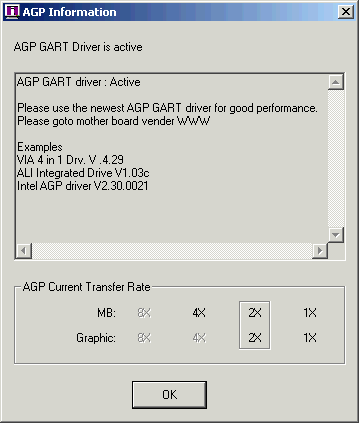As you'll
see in the upcoming benchmarks the Xabre 400 is fast, but it also had a few problems. It would run both AquaMark and CodeCreatures
benchmarks however there were artifacts on the screen or other abnormalities. We asked SIS about these issues, but haven't heard any definite
answer back yet.
The main menu screen of AquaMark would display
some unusual black horizontal lines that made reading text on the screen difficult,
but when the program was actually benchmarking the image looked fine. The problems
with CodeCreatures were more severe. While the benchmark was running, the
mountains were white for the entire test and the river was a blue-grey colour.
The butterflies has boxes for wings and the text on the screen was very
fuzzy.

We didn't have any visual problems with
the Xabre 400 in 3DMark2001SE, but it caused the test system to reboot
spontaneously a few times during the Dragothic demo. And not that it affects
performance much, but we were not able to get the Xabre 400 to run in 4x AGP mode on
the test Epox 8K3A+ no matter what we tried. Different drivers, BIOS settings
nothing would make it run at 4x AGP.

Handy Feature that tells us
the AGP Transfer rates...
The last problem I had is a little embarrassing.
I couldn't find the out how turn on Anti Alaising! Looking at the Xabre website, we see that they openly talk about "Jitter-Free AA" but I was
unable to find a place
to turn it on. If you know, please drop me a line (and be kind, I
looked and looked).
Overclocking:
We
ran into another hitch when it came to overclocking. Since the ECS and Xabre
reference drivers don't come with any overclocking options and Powerstrip doesn't recognize the 'GPU', we were
unable to overclock the videocard.
We can note however that during
testing the back of the PCB wasn't hot at all, so heat shouldn't be a problem for
the chipset. With the memory running at 500 MHz it did get quite warm
during testing and we were a bit surprised that ECS didn't put RAMsinks on the memory
to help keep them cool!
Since the EtronTech DRAM is rated
at 3.3 ns, it should have no problems going up to at least 606 MHz if
a suitable application becomes available.
